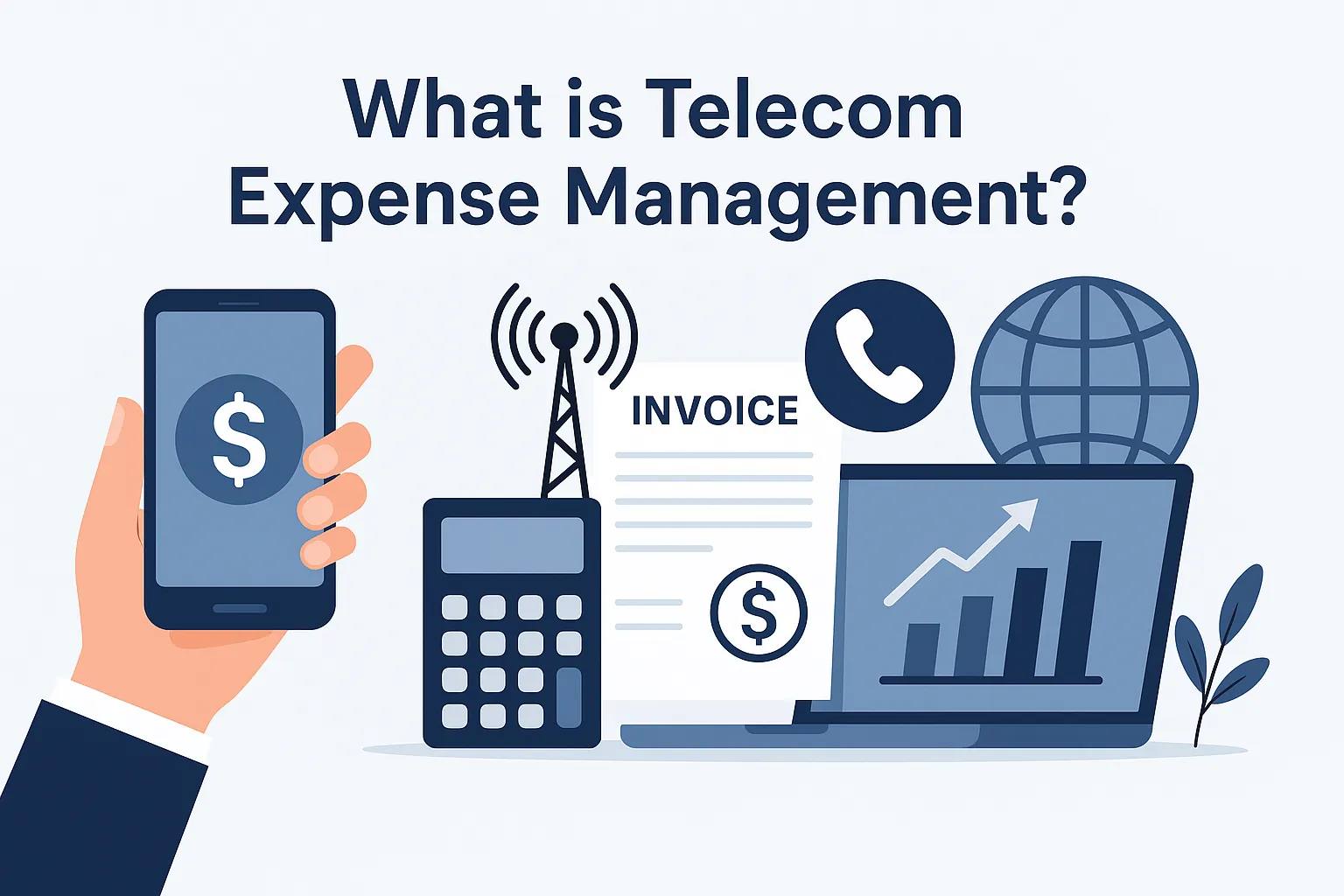
Executive Summary
Telecom Expense Management (TEM) is a strategic approach that organizations use to manage, control, and optimize the costs associated with telecommunications services and technology. It encompasses all activities related to monitoring, auditing, and analyzing telecom expenses, including voice, data, mobile, and cloud-based services.
In the modern business environment, organizations rely heavily on telecommunication networks, mobile devices, and internet services to stay connected internally and externally. As these services expand, so do their costs, creating challenges in cost control, budgeting, and operational efficiency. Telecom Expense Management provides a structured framework for organizations to gain visibility into their telecom spending, identify inefficiencies, negotiate contracts, and implement cost-saving measures.
TEM is not only about reducing costs; it also ensures compliance, improves operational efficiency, enhances vendor management, and provides insights that enable strategic decision-making. By leveraging automation, analytics, and best practices, businesses can achieve significant savings while maintaining high-quality communication services.
Table of Content
Introduction
Telecom services have become indispensable in today’s digital world. Organizations depend on mobile networks, broadband, cloud services, and unified communication systems to facilitate business operations, connect employees, and engage with customers. With the growing complexity of telecom services, managing expenses manually has become inefficient and error-prone.
Telecom Expense Management bridges this gap by providing a systematic approach to controlling telecom costs, ensuring accurate billing, and optimizing service usage. It combines technology, data analytics, process management, and strategic insights to help businesses achieve financial and operational efficiency.
TEM is relevant across industries, including manufacturing, healthcare, finance, retail, IT services, and government sectors. Companies of all sizes—small, medium, and large enterprises—can benefit from telecom expense management by achieving cost transparency, improved decision-making, and better resource allocation.
Core Concepts of Telecom Expense Management
- Cost Visibility – Understanding and monitoring all telecom expenses, including mobile, landline, internet, and cloud services.
- Invoice Management – Automating invoice collection, validation, and payment processes to prevent errors and overcharges.
- Usage Monitoring – Tracking service usage patterns to identify inefficiencies and optimize consumption.
- Contract and Vendor Management – Negotiating contracts, evaluating vendor performance, and ensuring compliance with service agreements.
- Cost Allocation and Reporting – Assigning costs to departments, teams, or projects for accountability and budget planning.
- Dispute Management – Identifying billing discrepancies and resolving disputes with service providers.
- Process Automation – Using technology to streamline expense tracking, reporting, and approval workflows.
- Compliance and Security – Ensuring adherence to regulations, data security standards, and internal policies.
- Strategic Optimization – Leveraging analytics to reduce costs, improve service quality, and enhance decision-making.
Key Processes in Telecom Expense Management

1. Invoice Collection and Validation
- Collecting invoices from multiple telecom providers across various services.
- Validating charges to ensure accuracy, identifying errors such as duplicate billing, incorrect rates, or unauthorized services.
2. Inventory and Asset Management
- Maintaining an up-to-date inventory of all telecom assets, including mobile devices, network equipment, and communication services.
- Tracking device allocation, lifecycle management, and service subscriptions to prevent unnecessary expenses.
3. Usage Analysis and Optimization
- Monitoring voice, data, and cloud usage across the organization.
- Identifying patterns of underutilized or overused services and recommending optimization strategies, such as data plan adjustments or device sharing.
4. Contract and Vendor Management
- Evaluating existing contracts with service providers to ensure cost-effectiveness and favorable terms.
- Negotiating renewal contracts, discounts, or bundled services to maximize value.
- Monitoring vendor performance to ensure service quality and SLA compliance.
5. Dispute Resolution and Billing Correction
- Detecting billing discrepancies, service outages, or unauthorized charges.
- Working with vendors to resolve disputes and secure credits or refunds.
6. Cost Allocation and Budgeting
- Allocating telecom costs to specific departments, teams, or projects for transparency.
- Using detailed reporting to support budgeting, forecasting, and financial planning.
7. Automation and Workflow Management
- Implementing TEM software to automate invoice processing, approvals, and reporting.
- Reducing manual errors, improving efficiency, and ensuring real-time expense visibility.
8. Reporting and Analytics
- Generating detailed reports on expenses, usage patterns, vendor performance, and potential savings.
- Using analytics to identify trends, optimize services, and support strategic decisions.
Related Articles to Explore
Telecom expense management is closely tied to operational efficiency, resource control, and financial management. Explore these guides:
- What Is Business Management? – Learn how organizational planning and control impact telecom cost efficiency.
- What Is Operations Management? – Understand how operational oversight helps reduce unnecessary telecom expenses.
- What Is Asset Management? – See how managing telecom assets effectively optimizes expenses.
- What Is Risk Management? – Discover how identifying financial and operational risks can prevent telecom overspending.
- What Is Data Management? – Explore how accurate data tracking and analysis improve expense monitoring.
Benefits of Telecom Expense Management
- Cost Reduction – Detecting billing errors, optimizing usage, and negotiating better contracts lead to significant savings.
- Improved Visibility – Centralized tracking of all telecom expenses ensures transparency.
- Operational Efficiency – Automating manual processes reduces errors and administrative workload.
- Enhanced Vendor Management – Monitoring vendor performance and contract compliance improves service quality.
- Compliance Assurance – Adhering to internal policies, regulatory requirements, and service-level agreements.
- Strategic Decision-Making – Analytics provide insights to guide cost optimization and IT investments.
- Budget Control – Detailed reporting allows departments to monitor and control telecom spending.
- Asset Optimization – Effective management of devices and subscriptions prevents waste and redundancy.
- Dispute Mitigation – Early detection and resolution of billing disputes reduce financial risks.
Types of Telecom Expense Management
- Mobile Expense Management (MEM) – Focuses on managing mobile devices, data plans, and carrier charges.
- Fixed-Line Expense Management – Includes landlines, voice circuits, and broadband services.
- Cloud and Unified Communication Expense Management – Optimizes cloud services, VoIP, collaboration tools, and SaaS platforms.
- Global Telecom Expense Management – Manages telecom expenses for multinational organizations across multiple regions and currencies.
- Managed TEM Services – Outsourcing TEM processes to specialized providers who handle cost optimization, analytics, and reporting.
Telecom Expense Management Strategies
- Centralized Expense Tracking – Consolidating all telecom expenses in one system for better visibility.
- Automation of Processes – Using TEM platforms to automate invoice validation, approval workflows, and reporting.
- Regular Audits and Reconciliation – Periodic auditing to detect errors, overcharges, or unauthorized services.
- Optimizing Service Plans – Aligning data, voice, and cloud plans with actual usage to avoid overpaying.
- Contract Negotiation – Renegotiating contracts and exploring competitive alternatives to reduce costs.
- Employee Usage Policies – Implementing policies to encourage efficient usage of telecom resources.
- Vendor Management Programs – Monitoring SLAs, service quality, and vendor compliance.
- Predictive Analytics – Forecasting future telecom needs and identifying areas for proactive savings.
- Integration with Financial Systems – Linking TEM software with ERP and accounting platforms for seamless expense management.
- Continuous Improvement – Regularly reviewing processes and adopting best practices to maximize ROI.
Tools and Technologies in Telecom Expense Management

- TEM Software Platforms: Tangoe, Calero-MDSL, Valicom, MDSL TEM, Avotus
- Invoice Management Tools: SAP Concur, Oracle TEM, Zantel TEM
- Analytics and Reporting Tools: Tableau, Power BI, QlikView for expense visualization
- Mobile Device Management (MDM) Tools: MobileIron, AirWatch, Microsoft Intune
- Workflow Automation Tools: Jira, Asana, ServiceNow for approval and ticket management
- Cloud Expense Management Platforms: CloudCheckr, Flexera for SaaS and cloud optimization
Challenges in Telecom Expense Management
- Complex Billing Structures – Telecom invoices often include multiple service lines and taxes, making errors hard to detect.
- Fragmented Systems – Organizations may have multiple carriers, devices, and platforms, complicating tracking.
- Rapid Technology Changes – Constant updates in mobile, cloud, and communication technologies require ongoing monitoring.
- User Behavior and Compliance – Employees may misuse services, increasing costs.
- Global Operations – Managing expenses across regions with different currencies, tax structures, and providers.
- Manual Processes – Without automation, TEM can be labor-intensive and error-prone.
- Vendor Negotiation Complexity – Requires expertise to secure optimal contracts and discounts.
Key Metrics and KPIs
- Total Telecom Spend – Comprehensive view of all telecom-related expenses.
- Cost per Device/User – Average expense per mobile device, employee, or department.
- Invoice Error Rate – Percentage of invoices with discrepancies.
- Savings Achieved – Amount saved through optimization and dispute resolution.
- Usage Efficiency – Percentage of allocated data or voice plans used effectively.
- Vendor SLA Compliance – Measuring adherence to service agreements and performance standards.
- Cost Allocation Accuracy – How precisely costs are assigned to departments, teams, or projects.
Real-World Applications
- Enterprise IT Management – Managing corporate mobile and network expenses efficiently.
- Healthcare Organizations – Optimizing telecom usage across hospitals, clinics, and remote care systems.
- Financial Services – Ensuring cost-effective communication channels for global operations.
- Retail Chains – Monitoring data, voice, and point-of-sale connectivity expenses.
- Government Agencies – Controlling telecom costs across multiple departments and public offices.
- Manufacturing Industry – Managing communication networks, IoT devices, and mobile workforce costs.
Future of Telecom Expense Management

- AI and Machine Learning Integration – Predicting anomalies, optimizing contracts, and improving expense forecasting.
- IoT Expense Management – Managing expenses for connected devices and smart infrastructure.
- Cloud and SaaS Cost Optimization – Incorporating cloud service management into TEM strategies.
- Real-Time Expense Tracking – Leveraging automated monitoring for immediate insights and proactive action.
- Global Expansion Support – Managing multi-country telecom operations with currency conversion and regulatory compliance.
- Enhanced Security and Compliance – Protecting sensitive communication data while ensuring regulatory adherence.
- Sustainability Integration – Reducing telecom waste, energy consumption, and promoting eco-friendly solutions.
Conclusion
Telecom Expense Management is a crucial strategy for modern organizations that rely heavily on communication and connectivity. By providing cost transparency, process efficiency, and actionable insights, TEM enables businesses to reduce unnecessary expenses, optimize telecom resources, improve vendor relationships, and support strategic growth.
With increasing reliance on mobile devices, cloud services, and complex telecom networks, TEM has evolved from simple invoice management to a comprehensive, data-driven solution. Organizations that implement effective TEM practices achieve cost savings, operational efficiency, and a competitive edge in a digital, connected world.


